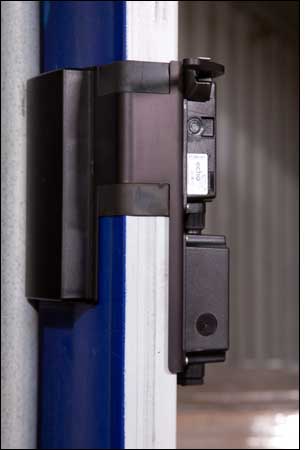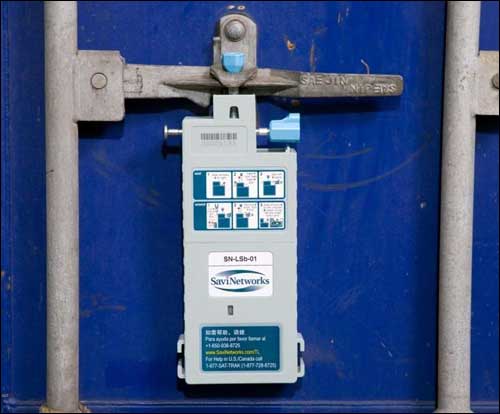Coscon Logistics, a subsidiary of the Cosco Container Lines Co. (Coscon), is employing new active tags and the SaviTrak software platform, provided by Savi Networks, to allow the logistics company’s customers to track the location and status of product-filled containers as they pass from China to destinations throughout the world.
Each tag contains a GPS receiver to track its location, as well as sensors that can monitor a container’s internal temperature and humidity, and detect when its door has been opened. When the tag is within range of a GPRS/GSM cellular base station, it transmits its location and sensor data to a back-end system, to be accessed by Coscon’s customers (the shippers of goods contained in those tagged containers). Each tag has a GPRS transmitter with a SIM card for global roaming, as well as four RF options (850, 900, 1800 and 1900 MHz) for worldwide operation. Savi Networks, which was established in 2005 as a joint venture between RFID systems provider Savi Technology and cargo terminal operator Hutchison Port Holdings. also provides another tag that includes a 2100 MHz option in addition to the quad GSM bands, for operation in Korea and Japan.
Coscon is a third-party shipping company that transports consumer goods and other products from China throughout the world, and back. The firm sought a system with which it could provide its customers with up-to-date information regarding their products’ location and condition via the Internet. With the SaviTrak system, Coscon provides the service, at a cost, to customers that request it. If the service is not requested, the container is not fitted with a tag and the shippers will therefore lack access to condition and location data.
Savi Networks provides Coscon’s clients with access to the system, as well as the tags, for a usage-based service fee. Savi Networks not only delivers the tags, but will also reship them to subsequent sites for reuse once they have been removed from a container.
“Our strategic customers now have the ability to get real-time information and location of their cargo during the transportation,” says Lin Hongbing, Coscon Logistics’ general manager. “It is very easy and convenient for us to collect environmental data in the container, such as humidity and temperature.”
Coscon is using one of two Savi Networks tags, depending on a customer’s particular needs—the LS model, containing a GPS receiver and security sensors to detect when a container has been opened, or the LSE model, which provides not only location and security data, but also temperature and humidity measurements. The tags are manufactured by an unnamed third party.
When a customer requests the service, a tag is attached to the container in which the shipment is loaded, and Coscon employees then link the tag’s unique identifier with the container number, the description and purchase order number of the products loaded within, and their destination and estimated time of arrival. This information is stored by Coscon and made available on a SaviTrak Web site that the company’s customers can access with a password.
When the tag picks up a signal from a GPRS base station, it transmits its unique identifier, along with any sensor data, including the sensor history if the container has been out of range of a base station (if it has been out to sea, for instance).
“It is an easy way [for the customer] to get access to the cargo,” Lin says. The system not only provides data when the customer logs into the system, it can also be set to send an immediate alert to both the client and Coscon in the event of an environmental change (such as a temperature rising above a preset threshold) or a security breach (such as a container door being opened when it should not be).
Coscon chose the Savi Networks solution, Lin says, because of its the ease of operation, and because it costs less than other wireless systems.
Savi Networks also offers an option that utilizes 433 MHz RFID tags compliant with the ISO 18000-7 standard, that communicate with RFID interrogators instead of GPRS base stations. However, explains Steve Sewell, the company’s senior VP, the system Coscon uses is GPRS-based in order to spare Savi Networks the expense of installing an RFID infrastructure (fixed readers) in every worldwide port. With GPRS, Sewell says, the tags can be read in nearly every port in the world. The LS and LSE tags have been available for approximately a month, he notes, and the system has been deployed by about a dozen logistics companies to date.
The tag’s SIM card allows the system to transmit to any GPRS/GSM base station around the world, at a rate of recurrence that can be set by the customer. When not within range of a base station, the tag continues to store sensor data, as well as GPS location coordinates, and that information is all uploaded when the container comes within range of a cellular base station. If the container experiences a security breach, or if a temperature issue occurs while the container is out at sea, its tag sends an immediate alert when the container comes within range of GPRS/GSM service at a port, thus letting system users know when the incident took place, and in which location.
There are two forms to the tag: one that clamps onto the edge of the container door, and another with a bolt that attaches to the door’s latch, thereby locking it. The sensors wired to the tag are placed inside the container, while the GPRS and GPS antennas are located outside. If containers are stacked below deck on a vessel, however, the GPS system is typically unable to capture location information—though the tag continues to store sensor data, which is transmitted, along with the time an incident occurred, when the container is within range of a GPRS/GSM base station.
Customers already using the Coscon system include those with high-value or high-risk items vulnerable to theft or spoilage, such as hazardous chemicals, electronics, pharmaceuticals or fresh produce. Eventually, Lin hopes the Savi Networks system will allow for the expedited movement of containers through customs at ports in Europe or elsewhere.
Currently, for example, the European Union is researching the establishment of smart and secure trade lanes as part of its Seventh Framework Program (FP7). If the secure trade-lanes program is established, Sewell says, the SaviTrak system could make it possible for Coscon’s containers to qualify for expedited clearance as they enter through customs without inspections, because of the greater security and shipment data history the system provides. Since the tags are removed when goods are unloaded from containers, the containers can also be tracked when they are moved by truck or rail across land, if a customer so chooses.
“We hope this useful technology would be expanded to more areas, such as customs issues,” Lin says. Sewell declines to reveal the number of Coscon customers using the service immediately, but indicates Savi Networks hopes the number will reach the thousands within the next few years.




